Tuesday, January 7, 2020
 Vacationing in a disaster zone would probably seem crazy, but “volunteer tourism” could actually help communities recover from natural disasters, said a new study. It can also offer a unique and rewarding experience for volunteers, if done properly.
Vacationing in a disaster zone would probably seem crazy, but “volunteer tourism” could actually help communities recover from natural disasters, said a new study. It can also offer a unique and rewarding experience for volunteers, if done properly.
“When disaster hits a tourist destination—whether fire, flood, cyclone or earthquake—tourists naturally stay away, leaving communities to deal with loss of income on top of costs of repair and recovery,” says study co-author Dr. David Beirman, from the University of Technology, Sydney.
“On the other hand, people who feel a natural curiosity, as well as a natural desire to help, are keen for experiences where they can interact with locals and make a difference,” he says.
However, volunteer tourism should not be confused with “disaster tourism” in which tourists immediately travel to a scene not to help but to look.
The researchers examined the impact of volunteer tourism programmes in Nepal in the wake of the April 2015 earthquake. They found that when it was done in an ethical manner that considered local conditions and the community, it could aid recovery and resilience.
The study “Engaging volunteer tourism in post-disaster recovery in Nepal” with UTS Business School co-authors Associate Professor Stephen Wearing and Dr. Simone Faulkner, was recently published in the Annals of Tourism Research.
The Nepal earthquake, which measured 8.1 on the Richter scale, killed nearly 9,000 people and injured 22,000, and caused severe damage to buildings and infrastructure.
In the four months that followed the Nepal earthquake, international tourism more than halved.
Initially, most relief organisations asked international volunteers not to come unless they had specific expertise, such as medical skills, building skills, or emergency response experience.
Then the Pacific Asia Travel Association and Nepalese tourism industry leaders worked together to produce the report of the Nepal Rapid Recovery Task Force, running workshops with more than 200 tourism industry leaders and professionals.
The strategy they came up with prioritised potential tourism re-growth markets, including volunteer tourism.
Nepal relaxed conditions to allow international tourists to volunteer on a wide range of projects including rebuilding homes and schools, interning in hospitals, supporting non-government organisations and re-establishing sustainable agriculture.
“Nepal’s tourism recovery since the April 2015 earthquake has been remarkable and as our research shows, volunteer tourism has been a significant driving force for that recovery,” says Dr. Beirman who was involved in the Nepal Rapid Recovery Taskforce.
In 2015, the year of the earthquake, just under 600,000 international tourists visited. By 2018 the number had reached an all-time record of almost 1.2 million. In 2019 it grew further.
The Nepal Association of Tour and Travel Agents says almost one third of the tours booked to Nepal in the two years after the earthquake comprised groups who combined tourism experiences with volunteering or philanthropy.
Tags: volunteer tourism
Thursday, April 25, 2024
Friday, April 26, 2024
Friday, April 26, 2024
Friday, April 26, 2024
Friday, April 26, 2024
Friday, April 26, 2024